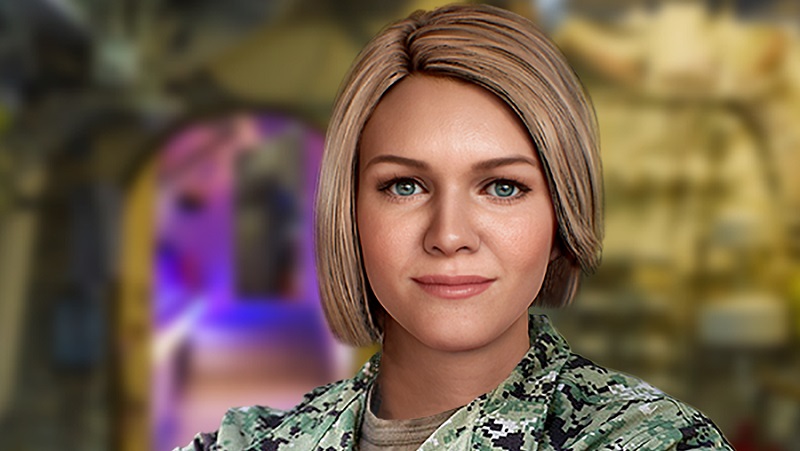
Amelia is soon coming to a Navy service desk near you.
The U.S. Navy and General Dynamics Information Technology (GDIT) are preparing to launch the innovative conversational AI solution – dubbed Amelia – which is capable of resolving customers’ requests without the involvement of a live representative as part of the ongoing Navy Enterprise Service Desk (NESD) program.
Navy personnel – including Sailors, Marines, and civilians at sea, ashore, and around the globe – can contact Amelia, the conversational AI acting as a Tier 1 agent, via phone and chat channels to receive virtual support. Amelia interprets the context behind the request and searches NESD’s knowledge based articles to assist users in resolving their tickets, creating a ticket, troubleshooting, and escalating issues, if necessary.
However, Amelia is just one of the key features of the NESD program.
The NESD program is a $136 million knowledge-based service desk solution currently working to modernize and consolidate more than 90 existing IT help desks across the Navy into a central service desk. The program leverages the latest automation, AI, and cloud technologies to provide centralized information technology services to Navy personnel whenever and wherever they need them.
Navy personnel require advanced capabilities and technologies to ensure they remain mission-focused in an ever-evolving battlespace. Therefore, the Navy Program Executive Office for Digital and Enterprise Services – the Navy’s enterprise-wide technology acquisition arm – partnered with GDIT to create NESD.
MeriTalk sat down with GDIT Navy & Marine Corps Sector CTO Travis Dawson, to discuss the launch of the Amelia program and the overall progress of the NESD project.
MeriTalk: What makes Amelia different from a normal bot?
Dawson: Amelia is not a chatbot, Amelia is a conversational AI solution. Amelia can recognize intent and interpret emotions behind a request to interact with the individual requesting help, making it a conversational interaction.
Unlike chatbots, which typically have a scripted back-end limiting a person’s ability to reach out for additional help or information, Amelia listens and interacts with users by reading natural language, understanding context, applying logic, inferring implications, and sensing emotions to determine the meaning behind a request and provide results.
MeriTalk: One of the improvements the NESD program intends to make is in the agency’s cybersecurity posture. How does that aim, if in any way, align with cybersecurity measures the Navy has undergone or the Pentagon’s massive shift to a zero trust framework?
Dawson: The idea behind the Enterprise Service Desk was consolidation and optimization. They wanted to take the disparate service desks that were out there and consolidate them to make it into one true enterprise. That alone increases the security posture of the network. So, you don’t have networks all over the place and they’re no longer sitting on-premises, they’re now cloud hosted. That alone was a decrease in the footprint that increased the security posture of the network
Now from a zero trust standpoint for identity management, we’re using the same thing as the rest of the Department. We’re using the Global Federated User Directory (GFUD) and we will move to the Naval Identity Services once the Navy gives us the OK.
MeriTalk: Anytime there is a shift away from a legacy system, especially in the government, there are usually challenges. What challenges have you faced, especially workforce culture challenges?
Dawson: Any new program comes with some sort of challenges. But in our progress, luckily, there hasn’t been a challenge that we haven’t been able to overcome. One thing we did notice, and you sort of expect, is a cultural shift in the Department in the way service. This legacy system was in place for several decades.
There is a culture change there when moving from a subject matter expert (SME)-based to a knowledge-based system. The legacy system was highly customized, and the direction moving forward is a more out-of-the-box approach. This provides an approved, standardized experience for every user.
And there are some learning curves there. We’ve been the trainers, so once we train the Tier 2+, they roll it out to the fleet and counterparts. We’ve also held town halls where folks have been able to ask questions to figure out how to navigate themselves around the system.
MeriTalk: What benefits does this program offer that Navy officials didn’t have before?
Dawson: The program has helped the Navy shift from an on-prem to secure cloud hosted environment, upgrade to a modernized IT Service Management suite, upgrade to a modernized omni-channel automated call distribution and move from a SME-based to Knowledge-based program. And now the Conversational AI implementation is imminent.
The technology efficiencies gained from this program are significant. The program has 99.99 percent system availability, 96 percent first contact resolution, 10-minute average handing time, 10 seconds average speed to answer when calling from the edge via secure cloud telephony, 25 percent deflection to Tier 0 enabling Sailor Self-Sufficiency, and 90 percent customer satisfaction results. The user experiences for Sailors and Marines ashore and afloat have been enhanced, and that alone makes us happy.
MeriTalk: When do you plan to fully deploy the program?
Dawson: We’re preparing to deploy Amelia in a pilot phase later this month and she will be phased in full for the remaining Navy and Marine Corps in July and August. Amelia is the last piece to the NESD program, which has been live since September of last year in the AWS GovCloud IL4 cloud environment, with imminent plans to move to IL5.
The September 2022 release was of all fundamental service desk capabilities including cloud-based IT service management to support all service desk tiers, knowledge management module including knowledge search capabilities, and self-service to guide users to resolve issues on their own.
MeriTalk: Are there any plans to move this further into a classified environment?
Dawson: The government does have plans to move the program, not just Amelia but the entire NESD program, to an IL6 environment in the near future.
